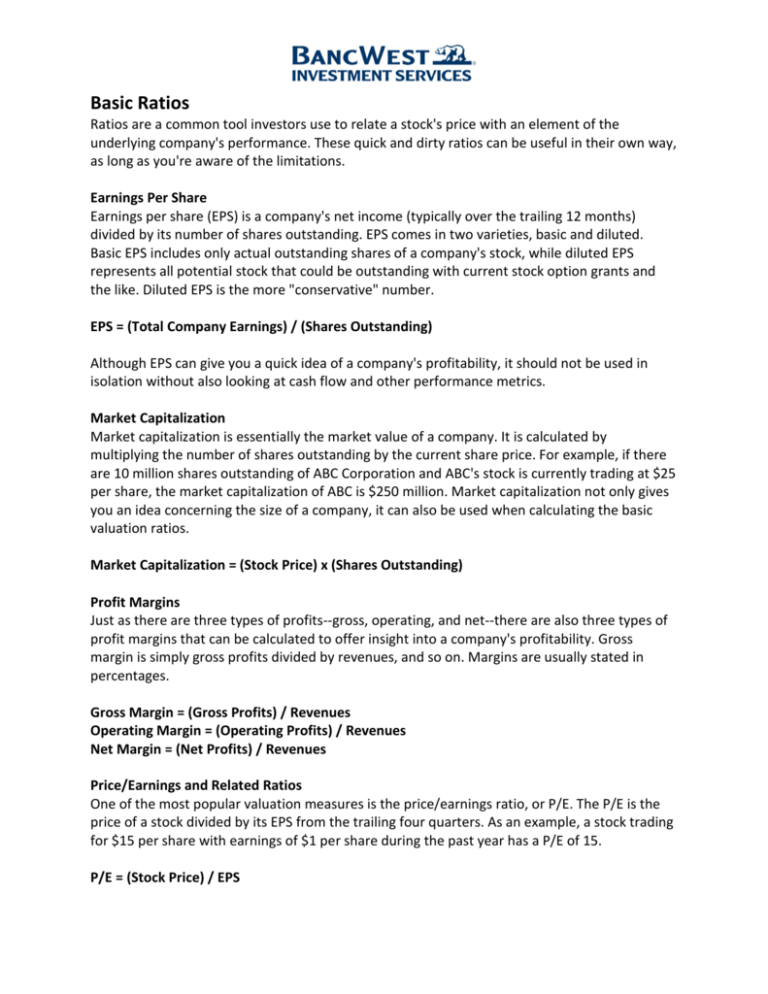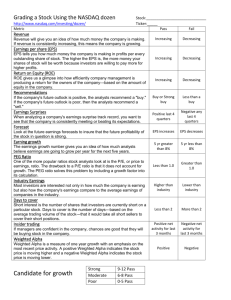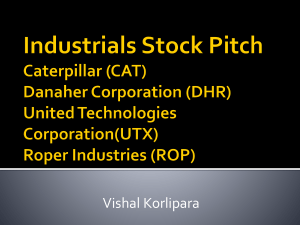
Basic Ratios
Ratios are a common tool investors use to relate a stock's price with an element of the
underlying company's performance. These quick and dirty ratios can be useful in their own way,
as long as you're aware of the limitations.
Earnings Per Share
Earnings per share (EPS) is a company's net income (typically over the trailing 12 months)
divided by its number of shares outstanding. EPS comes in two varieties, basic and diluted.
Basic EPS includes only actual outstanding shares of a company's stock, while diluted EPS
represents all potential stock that could be outstanding with current stock option grants and
the like. Diluted EPS is the more "conservative" number.
EPS = (Total Company Earnings) / (Shares Outstanding)
Although EPS can give you a quick idea of a company's profitability, it should not be used in
isolation without also looking at cash flow and other performance metrics.
Market Capitalization
Market capitalization is essentially the market value of a company. It is calculated by
multiplying the number of shares outstanding by the current share price. For example, if there
are 10 million shares outstanding of ABC Corporation and ABC's stock is currently trading at $25
per share, the market capitalization of ABC is $250 million. Market capitalization not only gives
you an idea concerning the size of a company, it can also be used when calculating the basic
valuation ratios.
Market Capitalization = (Stock Price) x (Shares Outstanding)
Profit Margins
Just as there are three types of profits--gross, operating, and net--there are also three types of
profit margins that can be calculated to offer insight into a company's profitability. Gross
margin is simply gross profits divided by revenues, and so on. Margins are usually stated in
percentages.
Gross Margin = (Gross Profits) / Revenues
Operating Margin = (Operating Profits) / Revenues
Net Margin = (Net Profits) / Revenues
Price/Earnings and Related Ratios
One of the most popular valuation measures is the price/earnings ratio, or P/E. The P/E is the
price of a stock divided by its EPS from the trailing four quarters. As an example, a stock trading
for $15 per share with earnings of $1 per share during the past year has a P/E of 15.
P/E = (Stock Price) / EPS
The P/E ratio gives a rough idea of the price investors are paying for a stock relative to its
underlying earnings. It is a quick and dirty way to gauge how cheap or expensive a stock may
be. Generally, the higher the P/E ratio, the more investors are willing to pay for a dollar's worth
of earnings from a company. High P/E stocks (typically those with a P/E above 30) tend to have
higher growth rates and/or the expectation of a profit turnaround. Meanwhile, low P/E stocks
(typically those with a P/E below 15) tend to have slower growth and/or lesser future
prospects.
The P/E ratio can also be useful when compared with the P/Es of similar
companies to see how the competitors stack up. In addition, you can compare a company's P/E
with the average P/E of the S&P 500 or some other benchmark index to get a rough idea of how
richly a stock is valued relative to the broader market.
One useful variant of P/E is earnings yield, or EPS divided by the stock price. Earnings yield is
the inverse of P/E, so a high earnings yield indicates a relatively inexpensive stock while a low
earnings yield indicates a more expensive one. It can be useful to compare earnings yields with
10- or 30-year Treasury bond yields to get an idea of how expensive a stock is.
Earnings Yield = 1 / (P/E ratio) = EPS / (Stock Price)
Another useful variant of P/E is the PEG ratio. A high P/E generally means that the market
expects the company to grow its profits rapidly in the future, so a much greater percentage of
the company's potential earnings are in the future. This means its market value (which reflects
those future earnings) is large relative to its present-day earnings.
The PEG ratio can help you determine if a stock's P/E has gotten too high in these cases by
giving you an idea of how much investors are paying for a company's growth. A stock's PEG
ratio is its forward P/E divided by its expected earnings growth over the next five years as
predicted by a consensus of Wall Street estimates. For example, if a company has a forward P/E
of 20 with annual earnings estimated to grow 10% per year on average, its peg ratio is 2.0.
Again, the higher the peg ratio, the more relatively expensive a stock is.
PEG = (Forward P/E Ratio) / (5-Year EPS Growth Rate)
As with other measures, the PEG ratio should be used with caution. PEG relies on two different
Wall Street analyst estimates--next year's earnings and five-year earnings growth--and thus is
doubly subject to the possibility of overly optimistic or pessimistic analysts. It also breaks down
at the extremes of zero-growth or hyper-growth companies.
Price/Sales Ratio
The price/sales (P/S) ratio is figured the same way as P/E, except with a company's annual sales
as the denominator instead of its earnings. An advantage to using the P/S ratio is that it is based
on sales, a figure that is much harder to manipulate and is subject to fewer accounting
estimates than earnings. Also, because sales tend to be more stable than earnings, P/S can be a
good tool for screening cyclical companies and other companies with fluctuating earnings
patterns.
P/S = (Stock Price) / (Sales Per Share) = (Market Capitalization) / (Total Sales)
When using the P/S ratio, it is important to keep in mind that a dollar of earnings has essentially
the same value regardless of the level of sales needed to create it. Meaning, a dollar of sales at
a highly profitable firm is worth more than a dollar of sales for a company with narrow profit
margins. This means comparing price/sales is generally useful only when comparing companies
in similar industries.
To understand the differences across industries, let's compare grocery stores with the medicaldevice industry. Grocery stores tend to have very small profit margins, earning only a few
pennies on each dollar of sales. As such, grocers have an average P/S ratio of 0.5. It takes a lot
of sales to create a dollar of earnings at a grocery store, so investors do not value those sales
dollars very highly.
Meanwhile, medical-device makers have much fatter profit margins. Relative to the grocer, it
does not take nearly as much in sales for a medical-device company to create a dollar in
earnings. It is little wonder the device makers have a high average price/sales ratio of 5.0. A
grocer with a P/S ratio of 2.0 would look quite expensive while a medical-device maker with the
same P/S could be dirt-cheap.
Price/Book Ratio
Another common valuation measure is the price/book ratio (P/B), which relates a stock's
market value with its book value (also known as shareholder equity) from the latest balance
sheet. Book value can be thought of as what would be left over for shareholders if a company
shutters operations, pays off its creditors, collects from its debtors, and liquidates itself.
Book Value Per Share = (Total Shareholders Equity) / (Shares Outstanding)
P/B = (Stock Price) / (Book Value Per Share) = (Market Capitalization) / (Total Shareholder
Equity)
There are caveats to using P/B. For instance, book value may not accurately measure a
company's worth, especially if the firm possesses significant intangible assets such as brand
names, market share, and other competitive advantages. The lowest price/book ratios tend to
be in capital-intensive industries such as utilities and retail, whereas the highest P/B ratios are
in fields such as pharmaceuticals and consumer products, where intangibles are more
important.
Price/book is also tied to return on equity (ROE), which is net income divided by shareholder
equity. Given two companies that are otherwise equal, the one with the higher ROE will have a
higher P/B ratio. A high P/B shouldn't be cause for alarm, especially if the company continually
earns a high ROE.
Price/Cash Flow
The price/cash flow (P/CF) ratio is not as commonly used or as well-known as the other
measures. It's calculated similarly to P/E, except that it uses operating cash flow instead of net
income as the denominator.
P/CF = (Stock Price) / (Operating Cash Flow Per Share)
Cash flow can be less subject to accounting shenanigans than earnings because it measures
actual cash, not paper or accounting profits. Price/cash flow can be helpful for firms such as
utilities and cable companies, which can have more cash flow than reported earnings.
Price/cash flow can also be used in place of P/E when there are so many one-time expenses
that reported earnings are negative.
Dividend Yield
There are two ways to make money when buying a stock--capital gains (when a stock goes up in
price) and dividend payments. Dividends are payments that companies make directly to
shareholders.
Dividend yield has been an important measure of valuation for many years. The dividend yield
is equal to a company's annual dividend per share divided by its stock price per share. So, if a
company pays an annual dividend of $2.00 and has a stock that trades for $100, its dividend
yield is 2.0%. If that same stock's price fell to $50 per share, its dividend yield would rise to
4.0%. Conversely, all else equal, the dividend yield falls when a stock's price goes up.
Dividend Yield = (Annual Dividends Per Share) / (Stock Price)
Stocks with high dividend yields are generally mature companies with few growth
opportunities. The economic reasoning behind this is that these companies can't find enough
promising projects to invest in for future growth, so they pay a larger portion of profits back to
shareholders. While utility companies are considered the typical dividend-paying stocks, you
can also find dividends in sectors with lots of room left for growth such as the pharmaceutical
industry.
Dividends have recently begun to garner investors' attention again. A big driver of this new
focus was a recent change in the United States tax code that lowered the tax rate on dividends.
So if you are looking for dividend income from your stock investments, remember that the best
high-yielding stocks have strong cash flows, healthy balance sheets, and relatively stable
businesses. And, if you're relying on that stream of dividends for income, checking for a steady
history of dividend payments is also a good idea.
The Bottom Line
Understanding the components of these ratios is key to learning the lingo of investors. It is also
essential in beginning to understand when a stock is cheap or expensive. The good news is that
if you invest long enough, the ratios highlighted here will become second nature.
You should consider the investment objectives, risks, and charges and expenses of the fund
or ETF carefully before investing. This and other information may be found in the
prospectus and/or, if available, the summary prospectus. To obtain one, please visit the
fund company’s website or if you are a BancWest Investment Services client, log in to
bankofthewest.com to access online. Always carefully read the prospectus and/or, if
available, the summary prospectus carefully before you invest or send money.
Money market funds are neither FDIC-insured nor guaranteed by the U.S. government or
government agency and are not deposits or obligations of, or guaranteed by, any bank.
Although money market funds attempt to maintain a constant net asset value of $1.00 per
share, there can be no guarantee that they will be able to do so. It is possible to lose money
by investing in money market funds.
© 2014 Morningstar, Inc. All Rights Reserved. The information contained herein: (1) is
proprietary to Morningstar and/or its content providers; (2) may not be copied or distributed; and
(3) is not warranted to be accurate, complete or timely. Neither Morningstar nor its content
providers are responsible for any damages or losses arising from any use of this
information. Past performance is no guarantee of future results.
Securities and variable annuities are offered through BancWest Investment Services, a registered
broker/dealer, Member FINRA/SIPC. Bank of the West and its various affiliates and subsidiaries
are not tax or legal advisors.
BancWest Investment Services is a wholly owned subsidiary of Bank of the West and a part of
the Wealth Management Group. BancWest Corporation is the holding company for Bank of the
West. BancWest Corporation is a wholly owned subsidiary of BNP Paribas.
Investment and Insurance Products:
NOT FDIC
INSURED
NOT BANK
GUARANTEED
MAY LOSE VALUE
NOT A
DEPOSIT
NOT INSURED BY ANY FEDERAL
GOVERNMENT AGENCY









